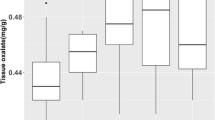Abstract
The pharmacokinetics of boron was studied in rats by administering a 1 ml oral dose of sodium tetraborate solution to several groups of rats (n=20) at eleven different dose levels ranging from 0 to 0.4 mg/100 g body weight as boron. Twenty-four-hour urine samples were collected after boron administration. After 24 h the average urinary recovery rate for this element was 99.6 ± 7.9. The relationship between boron dose and excretion was linear (r=0.999) with a regression coefficient of 0.954. This result suggests that the oral bioavailability (F) of boron was complete. Another group of rats (n=10) was given a single oral injection of 2 ml of sodium tetraborate solution containing 0.4 mg of boron/100 g body wt. The serum decay of boron was followed and found to be monophasic. The data were interpreted according to a one-compartment open model. The appropriate pharmacokinetic parameters were estimated as follows: absorption half-life, t 1/2a=0.608±0.432 h; elimination half-life, t 1/2=4.64±1.19 h; volume of distribution, Vd=142.0±30.2 ml/100 g body wt.; total clearance, C tot=0.359 ± 0.0285 ml/min per 100 g body wt. The maximum boron concentration in serum after administration (C max) was 2.13 ± 0.270 mg/l, and the time needed to reach this maximum concentration (T max) was 1.76 ± 0.887 h. Our results suggest that orally administered boric acid is rapidly and completely absorbed from the gastrointestinal tract into the blood stream. Boric acid in the intravascular space does not have a strong affinity to serum proteins, and rapidly diffuses to the extravascular space in proportion to blood flow without massive accumulation or binding in tissues. The main route of boron excretion from the body is via glomerular filtration. It may be inferred that there is partial tubular resorption at low plasma levels. The animal model is proposed as a useful tool to approach the problem of environmental or industrial exposure to boron or in cases of accidental acute boron intoxication.
Similar content being viewed by others
Author information
Authors and Affiliations
Additional information
Received: 1 December 1997 / Accepted: 24 March 1998
Rights and permissions
About this article
Cite this article
Usuda, K., Kono, K., Orita, Y. et al. Serum and urinary boron levels in rats after single administration of sodium tetraborate. Arch Toxicol 72, 468–474 (1998). https://doi.org/10.1007/s002040050530
Issue Date:
DOI: https://doi.org/10.1007/s002040050530




